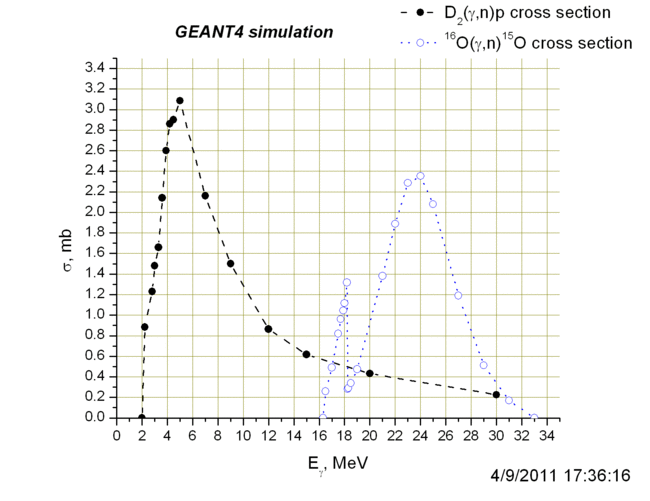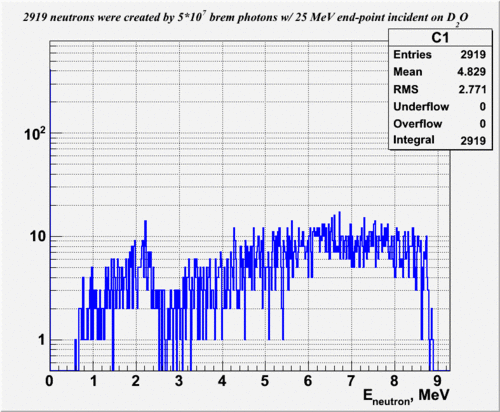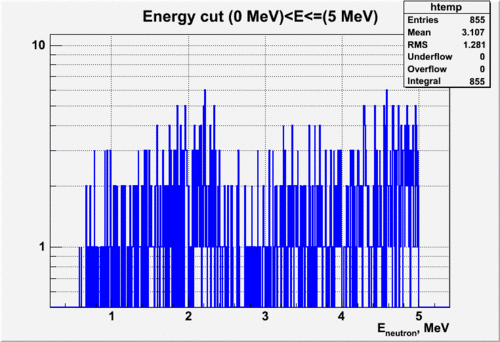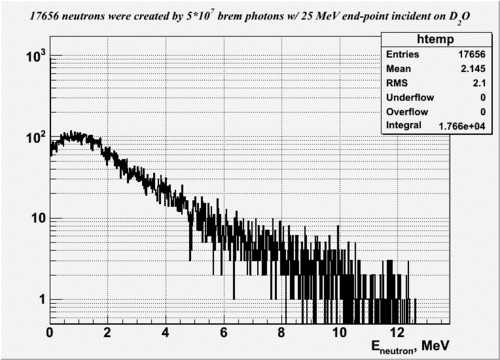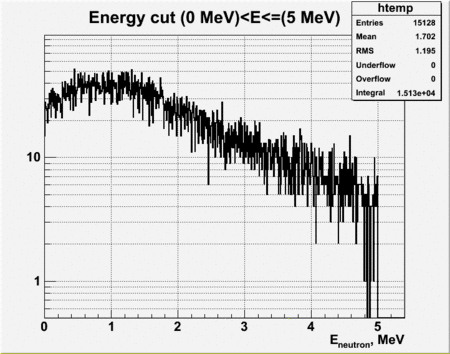Difference between revisions of "D2O photodisintegration simulation"
| Line 16: | Line 16: | ||
[[File:D2_neutron_yield2.gif | 500 px]] [[File:D2_neutron_yield_cut.gif | 450 px]] | [[File:D2_neutron_yield2.gif | 500 px]] [[File:D2_neutron_yield_cut.gif | 450 px]] | ||
| − | So, if we apply the energy cut in neutron spectrum which is a sum of neutrons coming from <math>O16(\gamma,n)O15</math> and <math>D_2(\gamma,n)p</math> reactions at (0MeV)<E<=5MeV, then the ratio of unpolarized | + | So, if we apply the energy cut in neutron spectrum which is a sum of neutrons coming from <math>O16(\gamma,n)O15</math> and <math>D_2(\gamma,n)p</math> reactions at (0MeV)<E<=5MeV, then the ratio of unpolarized neutrons from <math>O16(\gamma,n)O15</math> and polarized neutrons from <math>D_2(\gamma,n)p</math> will be <math>855/15128=0.056</math>. In the same time we will loose <math>(16799-15128)/15128=11%</math> of the "good" high energy neutrons produced in <math>D_2(\gamma,n)p</math> reaction. Binning is the same for all the plots. |
I will verify if those spectra and all the ratios are the same in the case where we use the geometrical constrains applied by the detectors placement. | I will verify if those spectra and all the ratios are the same in the case where we use the geometrical constrains applied by the detectors placement. | ||
Revision as of 04:16, 11 April 2011
The result of GEANT4 simulation of neutron photoproduction on deuterium and oxygen-16 is presented below:
Neutron yield () from (90% concentration) in reaction is presented below. Initially brem photons with 25 MeV end-point energy were thrown on the target. 410 neutrons initially produced got absorbed in the target (E=0MeV) and 2509 neutrons will likely escape the target. Figure in blue on the left is the total energy spectrum of neutrons created in reaction . Figure in blue on the right is the neutron energy spectrum with energy cut applied.
Neutron yield () from (90% concentration) in reaction is presented below. Initially brem photons with 25 MeV end-point energy were thrown on the target. 857 neutrons initially produced got absorbed in the target (E=0MeV) and 16799 neutrons will likely escape the target. Figure in black on the left is the total energy spectrum of neutrons created in reaction . Figure in blue on the right is the neutron energy spectrum with energy cut applied.
So, if we apply the energy cut in neutron spectrum which is a sum of neutrons coming from and reactions at (0MeV)<E<=5MeV, then the ratio of unpolarized neutrons from and polarized neutrons from will be . In the same time we will loose of the "good" high energy neutrons produced in reaction. Binning is the same for all the plots.
I will verify if those spectra and all the ratios are the same in the case where we use the geometrical constrains applied by the detectors placement.
